Jongmyo may refer to:
- Jongmyo (shrine), a kind of shrine in the East Asian cultural sphere
- Jongmyo (Seoul), a shrine of that type in Seoul, Korea
Jongmyo may refer to:

Korean court music comprises three main musical genres: aak, an imported form of Chinese ritual music; a pure Korean form called hyangak; and a combination of Chinese and Korean styles called dangak.
AakKorean pronunciation:[a.ak] is a genre of Korean court music. It is an imported form of the Chinese court music yayue, and means "elegant music". Aak was performed almost exclusively in state sacrificial rites, and in the present day it is performed in certain Confucian ceremonies.
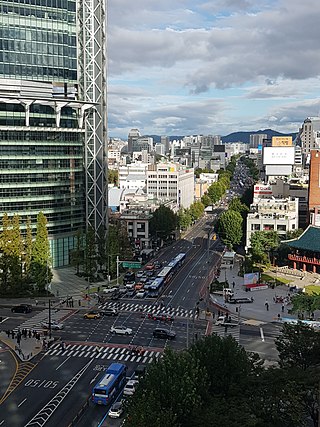
Jongno or Jong-ro is a trunk road and one of the oldest major east–west thoroughfares in Seoul, South Korea. Jongno connects Gwanghwamun Plaza to Dongdaemun.

A National Treasure (Korean: 국보) is a tangible treasure, artifact, site, or building which is recognized by the South Korean government as having exceptional artistic, cultural and historical value to the country. The title is one of the eight State-designated heritage classifications assigned by the administrator of the Cultural Heritage Administration (CHA) in accordance with the Cultural Heritage Protection Act after deliberation by the Cultural Heritage Committee.
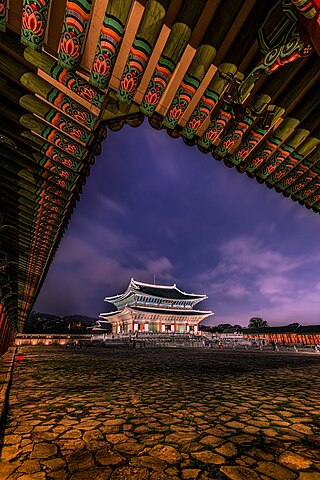
Korean architecture refers to an architectural style that developed over centuries in Korea. Throughout the history of Korea, various kingdoms and royal dynasties have developed a unique style of architecture with influences from Buddhism and Korean Confucianism.

Jongno 3(sam)-ga Station is an underground station on lines 1, 3 and 5 of the Seoul Subway in South Korea.

Jongmyo (Korean: 종묘) is a Confucian shrine in the Jongno District of Seoul, South Korea. It was originally built during the Joseon period (1392–1897) for memorial services for deceased kings and queens. According to UNESCO, the shrine is the oldest royal Confucian shrine preserved and the ritual ceremonies continue a tradition established in the 14th century. Such shrines existed during the Three Kingdoms of Korea period (57–668), but these have not survived. The Jongmyo Shrine was added to the UNESCO World Heritage list in 1995.

The National Gugak Center, located in Seoul, South Korea, is the primary institution of learning for Korean traditional music, including both court music and folk music. It was founded in 1951 through a merger of Korean musical organizations.

Munmyo is Korea's primary temple of Confucius. It is located in central Seoul, South Korea, on the campus of Sungkyunkwan University.
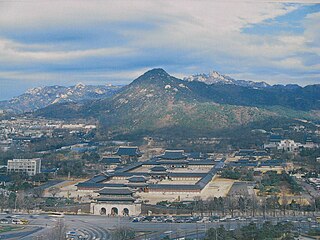
Jongno District is a district in central Seoul, South Korea. It is the historic center of Seoul, and contains the Joseon-era royal palace Gyeongbokgung and the former presidential residence, the Blue House.

The Intangible Cultural Heritage are aspects of intangible culture that the government of South Korea has officially designated for preservation in accordance with the 1962 Cultural Property Protection Law. They are proclaimed and maintained by South Korea's Cultural Heritage Administration.

Jongmyo jerye (Korean: 종묘제례) or jongmyo daeje (종묘대제) is a traditional rite held for worshipping the deceased Joseon monarchs in Jongmyo Shrine, Seoul, South Korea. It is held every year on the first Sunday of May. The jongmyo rite is usually accompanied with the court music playing (Jerye-ak) and dance called Ilmu or line dance. Jongmyo jerye and jeryeak were designated as the first of South Korea's Masterpieces of the Oral and Intangible Heritage of Humanity by UNESCO in 2001.

The Imperial Ancestral Temple, or Taimiao of Beijing, is a historic site in the Imperial City, just outside the Forbidden City, where during both the Ming and Qing Dynasties, sacrificial ceremonies were held on the most important festival occasions in honor of the imperial family's ancestors.
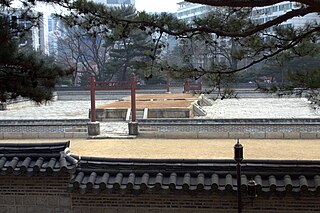
Sajikdan (Korean: 사직단) is a Neo-Confucian altar located in Seoul, South Korea. It was built and used during the Joseon period to perform rituals related to soil and grain.

An ancestral shrine, hall or temple, also called lineage temple, is a temple dedicated to deified ancestors and progenitors of surname lineages or families in the Chinese tradition. Ancestral temples are closely linked to Confucian philosophy and culture and the emphasis that it places on filial piety.
The following is a timeline of the history of the city of Seoul, South Korea.
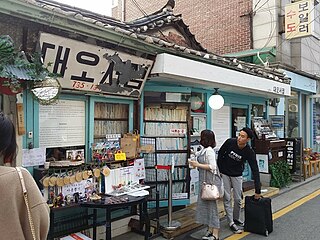
Seochon (Korean: 서촌) is one of the oldest neighborhoods of Jongno-gu in northern Seoul, South Korea. It translates as "West village" or "Western village" as it is west of the Gyeongbok Palace. It is also thought that the name could have derived from Mt Inwangsan as the mountain used to be called "Seosan" or "old mountain in the west." Seochon is traditionally associated with the Joseon dynasty and Korean literature.

Bacchus Ladies are elderly female prostitutes in Seoul, South Korea.
A Zongmiao (宗廟) or Taimiao (太廟) is an ancient Chinese ancestral temple dedicated to the ancestors of nobles and monarchs and their spirit tablets. Zong (宗) means ancestral and Miao (廟) means temple. The earliest known Zongmiao was discovered at Yinxu Palace and Temple Site in Anyang, Henan Province, China, and is yet to be excavated. At that time, commoners did not have the right to set up ancestral shrines, "The Xunzi-Liturgy" reads: "Therefore, those who have the world serve seven generations, those who have a country serve five generations, those who have five times the land serve three generations, those who have three times the land serve two generations, those who hold their hands and eat are not allowed to set up a temple, so the thick accumulation of the flow of water is wide, and the thin accumulation of water is narrow. "